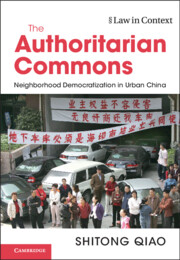Book contents
- The Authoritarian Commons
- Law in Context
- The Authoritarian Commons
- Copyright page
- Dedication
- Contents
- Figures
- Tables
- Acknowledgments
- Abbreviations
- Introduction
- Part I Theory
- Part II A Tale of Three Cities
- 3 The Three Styles of Authoritarianism
- 4 Rule of Law for Democracy
- 5 Property
- Part III Benefits and Risks
- Conclusion
- Appendix I: Summary of Research Methods
- Appendix II: Survey Data and Analysis
- Notes
- Bibliography
- Index
5 - Property
A Political Right, Social Right, or Legal Right?
from Part II - A Tale of Three Cities
Published online by Cambridge University Press: 21 December 2024
- The Authoritarian Commons
- Law in Context
- The Authoritarian Commons
- Copyright page
- Dedication
- Contents
- Figures
- Tables
- Acknowledgments
- Abbreviations
- Introduction
- Part I Theory
- Part II A Tale of Three Cities
- 3 The Three Styles of Authoritarianism
- 4 Rule of Law for Democracy
- 5 Property
- Part III Benefits and Risks
- Conclusion
- Appendix I: Summary of Research Methods
- Appendix II: Survey Data and Analysis
- Notes
- Bibliography
- Index
Summary
The homeowners’ movements in Beijing, Shanghai, and Shenzhen differ by both the scope of their property rights claims and the concomitant ways in which they claim those rights. The leading homeowners in Beijing are political entrepreneurs, devoting themselves more to systemic change and even Chinese democracy than to the self-governance of their individual neighborhoods. The leading homeowners in Shenzhen are social entrepreneurs who navigate through the social, legal, and bureaucratic maze to claim absolute homeownership sovereignty. The defining characteristic of homeowners in Shanghai is respect for laws and rules.
Keywords
- Type
- Chapter
- Information
- The Authoritarian CommonsNeighborhood Democratization in Urban China, pp. 61 - 82Publisher: Cambridge University PressPrint publication year: 2025

